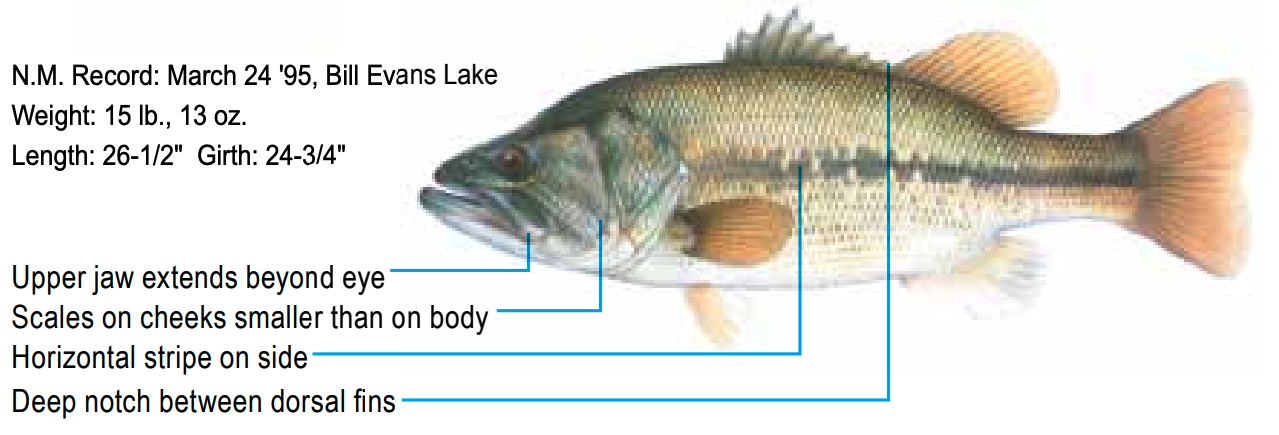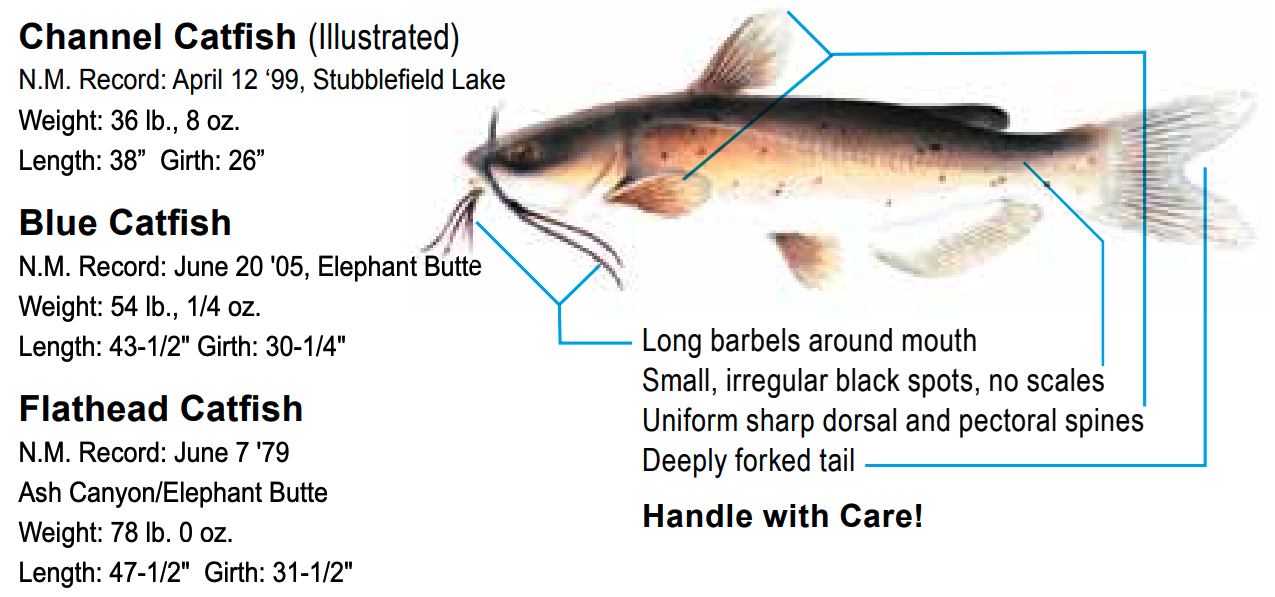Warm Water Regulations
Warm Water Game Fish
Smallmouth Bass

Largemouth Bass

Bluegill

Catfish

Striped Bass

White Bass

Walleye

Crappie

Tiger Muskie
(only in Bluewater Lake and Quemado Lake)

Northern Pike

Where To Find Warm Water Species
Largemouth Bass
Some of the best largemouth bass fishing in New Mexico is found in the smaller lakes. Bill Evans Lake offers opportunities for trophy-sized fish. Conchas and Ute lakes provide good fishing opportunities. Concentrate on structure wherever available.
Smallmouth Bass
Smallmouth bass populations are very good at Navajo Lake, Ute Lake and Conchas Lake—and though more abundant at Navajo, any of these lakes provide good opportunities to catch large fish. Smallmouth bass typically gravitate near rocky areas and ledges. Fishing around these locations spring through fall is suggested.
Walleye
Ute, Caballo Lake and Conchas lakes provide good walleye numbers. Fishing is usually best from April through May, after fish have spawned.
Catfish
Catfish populations and sizes are highest in New Mexico’s larger reservoirs. Blue catfish up to 40 pounds are common at Elephant Butte Lake. Very good populations of large channel catfish can be found at Conchas, Caballo, Storrie and Ute lakes. Shallow murky water near inlets provides good fishing during late evening and night.
White Bass and Hybrid Striped Bass (Wipers)
White bass fishing is outstanding at Elephant Butte Lake and Ute Lake. Brantley, Conchas and Sumner lakes also provide good opportunities for catching white bass. From late spring to early summer, exciting opportunities occur in areas where shad or other forage fish congregate. Hybrid striped bass (wipers) were stocked into Caballo Lake in 2022 and should be available to catch this year.
Tiger Muskie
Tiger muskies are a crossbreed of northern pike with muskellunge. Bluewater Lake currently supports a high-density population of tiger muskies. Above average catch rates at this lake for most of the summer are common.
Rainbow Trout
Warm-water fish, also known as spiny-ray fish, include species such as largemouth bass, smallmouth bass, walleye, catfish, sunfish, white bass, and striped bass. Many of these fish occur wild in self-sustaining populations throughout New Mexico. Some of these populations depend on supplemental stocking. Each year, NMDGF stocks thousands of largemouth bass and channel catfish and millions of walleye fry to increase and improve angling opportunities.
Warm Water Regulations
Trotline or Set Line Use
A trotline (throw line, limb line, set line, jug line, or "Yo-yo" line) is a line without a rod or reel attached. It does not need to be handheld nor closely attended. Trotlines are limited to 25 hooks. Trotlines belonging to two or more people may not be joined or tied together. Anglers may not fish with more than one trotline. Anglers may not check, pull up, or tamper with the trotline of another person. Any person using a trotline must attend it personally at least once every calendar day and remove or release all game fish that are caught. A Second Rod Validation is not required to fish witha trotline. A trotline does not count toward an anglers limit on rods. Anglers may fish with a trotline and a rod or a trotline and two rods (with Second Rod Validation) at the same time.
A person fishing with a trotline must attach an identification tag that is visible above the water line. The identification tag must list the angler’s Customer Identification Number (CIN). Anglers 11 years of age and younger must list their Customer Identification Number (CIN) or their name and date of birth on the identification tag.
Trotlines may be used to take game fish only in the river reaches and lakes listed by drainage in the table below.
Rivers | Lakes | |
Rio Grande drainage | Rio Grande mainstem from its confluencewith the Chama River downstream to New Mexico/Texas state line and Chama River mainstemfrom the northern boundary of the Monastery ofChrist in the Desert downstream to Abiquiu Lake | Abiquiu Lake, Cochiti Lake, Elephant Butte Lake, and Caballo Lake |
Pecos River drainage | Pecos River mainstem downstream of I-25 (excluding Villanueva State Park) to the New Mexico/Texas state line and all tributaries within Chavez, De Baca, Eddy, Guadalupe, and San Miguel (downstream of I-25) Counties | Santa Rosa Lake, Sumner Lake, Lake Avalon, Brantley Lake, Six Mile Lake, Ten Mile Reservoir, and Red Bluff Reservoir |
Canadian River drainage | Canadian River mainstem and all tributaries downstream and east of I-25 to the NewMexico/Texas state line | Stubblefield Lake, Laguna Madre, Maxwell Lake 14, Springer Lake, Conchas Lake, and Ute Lake |
San Juan River drainage | San Juan River mainstem from U S 64 bridge at Blanco downstream to the Navajo Nation boundary at the Hogback canal diversion | Navajo Lake |
Gila River and San Francisco River drainage | Gila River mainstem from its confluencewith the east fork downstream to the New Mexico/Arizona state line and San Francisco Rivermainstem from U S 180 bridge at Alma downstream to the New Mexico/Arizona state line | None |
Warm Water Size and Bag Limits
Black Bass - 5 per day
- Largemouth and spotted: 14-inch minimum size limit
- Smallmouth: 12-inch minimum size limit
- Smallmouth at Conchas Reservoir and Ute Reservoir: 14-inch minimum size limit
- Smallmouth bass in Rio Grande within Taos County and Rio Arriba County: no minimum size limit
Catfish (all species, except bullheads and Special Summer Catfish) - 15 per day
- In the Animas River and San Juan River, in San Juan County, there are no bag or possession limits.
Crappie - 20 per day
Striped Bass - 1 per day
- In the Animas and San Juan Rivers, in San Juan County, there is no bag or possession limit.
Northern Pike - 10 per day
- In Eagle Nest Lake, there are no bag or possession limits. Northern pike may not be returned intentionally to the lake.
Tiger Muskie - 1 per day
- 40-inch minimum size limit. Found only in Bluewater Lake and Quemado Lake.
Walleye - 5 per day
White Bass and Hybrid Striped Bass (Wipers) - 25 per day
Yellow Perch - 30 per day
All other warmwater game fish (bluegill, sunfish, bullheads, freshwater drum) - 20 per day
Possession Limits
The possession limit for each species is twice the daily bag limit.
Special Warm Waters
Special Summer Catfish Waters
Many small lakes and ponds are stocked from May – September with 17-inch or longer channel catfish. These waters offer great opportunities throughout the summer to catch big catfish. To make these unique angling opportunities possible, reduced bag limits have been established on these waters. Trotlines may not be used in Special Summer Catfish Waters.
Special Summer Catfish Waters - 2 per day
- Special catfish limit applies to: Alto Lake, Alumni Pond, Bataan, Blue Hole Park Pond, Bosque Redondo, Carrizozo, Chaparral, Conoco Lake (Loco Lagoon), Corona, Dennis Chavez Pond, Escondida, Estancia Park Lake, Eunice, Grants Riverwalk Pond, Greene Acres, Green Meadow, Harris Pond, Jal Lake, Lake Van, Liam Knight Pond, McGaffey Lake, Ned Houk, Oasis State Park, Pecos River within Villanueva State Park, Perch Lake, Rancho Grande Ponds, Roswell Kid’s Pond (Spring River Park), Timberon Ponds, Tingley Beach, Trees Lake and Young Pond.
Trophy Bass Waters
Lake Roberts, Clayton Lake and Bill Evans Lake are Trophy Bass Waters. These fisheries provide ideal conditions for largemouth bass weighing five pounds or more. Since these lakes are small, in order to maintain sustainable trophy fisheries the bag limit for largemouth bass is reduced. Legal length is a minimum size of 14 inches. Spearfishing and bow fishing for largemouth bass in these lakes is prohibited.
Trophy Bass Waters - 2 per day
- Largemouth bass, 14 inches or longer. Bill Evans, Clayton Lake and Lake Roberts.
Possession Limits
Special Summer Catfish Waters: The possession limit is four fish.
Trophy Bass Waters: The possession limit is two fish 14 inches or larger.
